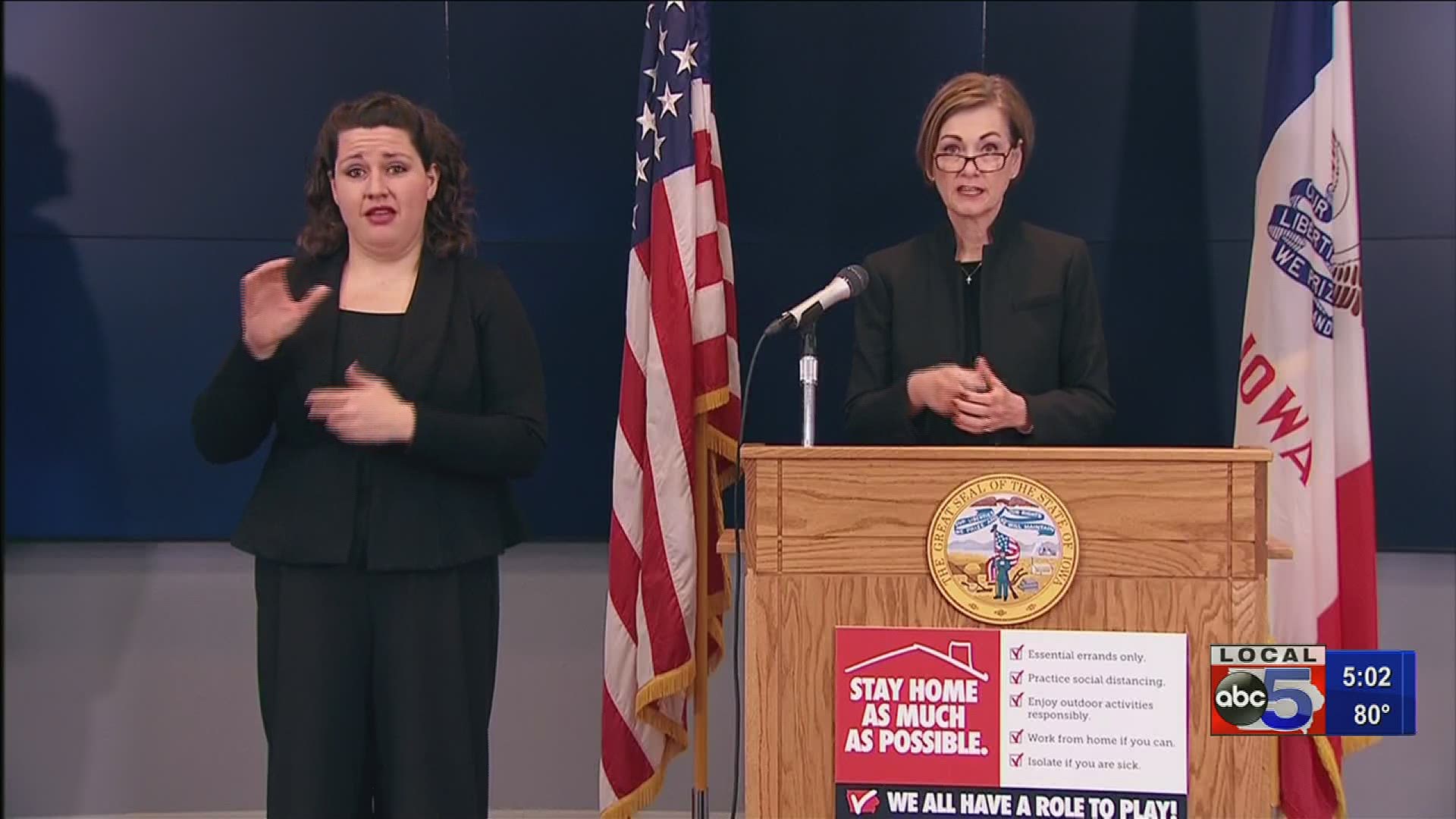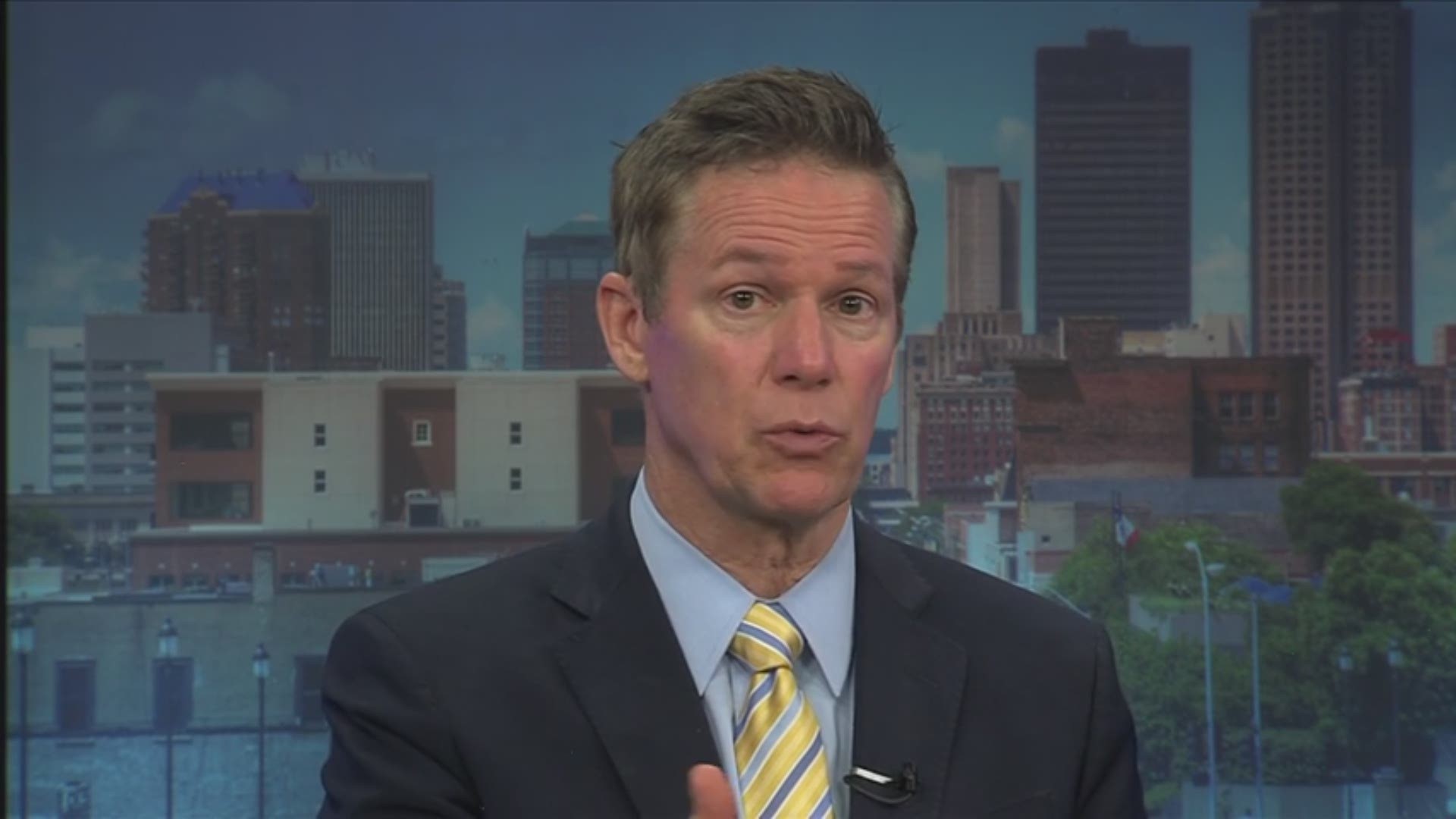IOWA, USA — Gov. Reynolds spent much of her time at Tuesday's press conference on the state's COVID-19 response detailing the Iowa National Guard's role in delivering personal protective equipment and establishing medical coordination centers.
An additional 102 confirmed cases in Iowa means the total number of positive cases is 1,048. Three new counties—Buena Vista, Delaware and Greene—have positive cases. 78 out of Iowa's 99 counties have positive cases of COVID-19.
Negative tests are now at 11,670 in the state. There are 1,690 available tests through the State Hygienic Lab.
As of Monday night, 104 Iowans are hospitalized and 341 have recovered.
Another Iowan died from COVID-19 complications. They were an elderly adult (81+) from Benton County. Total fatalities in the state is 26.
Iowa National Guard's role during pandemic
Maj. Gen. Ben Corell, Adjutant General of the Iowa National Guard, said over 200 soldiers and airmen are on duty to directly support the state's response efforts to COVID-19.
For example, National Guard transportation units continue to deliver personal protective equipment (PPE) to county emergency management facilities across the state.
Since the missions began on March 24, PPE has been delivered to all 99 counties in the state. Some counties have seen multiple deliveries.
"This is a critical mission that we're conducting every day keeping this vital PPE pipeline flowing to points of need across the state almost as quickly as it arrives in Iowa," Corell said.
Corell activated three additional task force headquarters across the state to support the National Guard's pandemic response activities.
These are being led by a senior Iowa National Guard commander. They are designed to "provide planning, coordination, communication, and command and control of military forces activated in support of our local, state and federal partners on our regional response efforts within the state," according to Corell.
"Iowans are used to seeing our soldiers and airmen responding to floods, tornadoes, winter storms, and other natural disasters. The strength of our organization is in the soldiers and airmen who live and work in your community while serving part time until we need them to answer the call. We are now answering the call and we will always be ready to support our fellow Iowans," Corell said.
Regional Medical Coordination Center locations, explained
At the governor's direction, the Iowa National Guard established six Regional Medical Coordination Centers (RMCCs) in support of the Iowa Department of Public Health in the Iowa Healthcare Coalitions.
RMCCs are a "critical" resource to support healthcare providers during the COVID-19 pandemic, according to Reynolds.
Corell explained exactly what RMCCs do.
"In short, RMCCs help facilitate multi-agency and civilian-partner communication, critical information sharing and coordination of healthcare-related resources across the regions that they serve," he said.
There are six locations in the state, all located at Iowa National Guard armories:
- Region 1: Camp Dodge
- Region 2: Mason City
- Region 3: Sioux City
- Region 4: Council Bluffs
- Region 5: Iowa City
- Region 6: Cedar Rapids
Under normal conditions, Iowa's Healthcare Coalition regions are "served by separate health care systems, community hospitals and independent providers," according to Reynolds.
"But during an emergency, especially one the size and scope of a worldwide pandemic, it may become necessary to pool resources and work together as one health system serving the needs of a region or the entire state," Reynolds said.
This is exactly what RMCCs are planning for.
Reynolds said the locations can enable care coordination between providers to make sure Iowans are receiving "the right care at the right time and in the right place."
This is done so by keeping track of essential data like current patients hospitalized or how many ventilators are available in the region.
"Understanding our bed and vent capacity and intensive care capabilities within a region enables us to effectively coordinate care if patient volume dramatically increases," Reynolds said.
If critical equipment is in short supply in one area, the FMCC will coordinate moving equipment from one location to another. Patients are also subject to be transferred to another facility if their condition demands a higher level of care, according to Reynolds.
"As we progress toward an anticipated peak of positive cases later this month, the RMCCs ability to monitor patient volume, acuity and availability of resources will better enable our health systems to surge and flex to accommodate increased demand across the region," Reynolds said.
What about the metrics being used to determine mitigation tactics?
According to a release from the Office of Auditor of State, Gov. Reynolds failed to answer basic questions about the pandemic assessment tool being used to determine which mitigation tactics to use in the state.
When asked about the tool during Tuesday's press conference, Reynolds said she "spent the entire press conference" on Friday talking about the pandemic assessment tool.
"We spent the whole press conference really identifying the experts that we have the epidemiologist, team, the number of years that they've been working on various outbreaks and, and we also said that we've got the metrics that we're looking at, but we're also looking at different assumptions," Reynolds said.
FRIDAY'S PRESS CONFERENCE: 'You can't just look at a map and assume no action has been taken': Gov. Reynolds defends COVID-19 response
This tool assigns points to the six different regions of the state by using data. The four metrics that Dr. Caitlin Pedati with the IDPH developed are:
- Percent of population greater than 65 years of age
- Percent of identified cases requiring hospitilzation
- Rate per 100,000 population in the past 14 days
- Long term care outbreaks
State Auditor Rob Sand said he asked the governor for background information on the tool twice since last Thursday. A letter sent from Sand to the governor on Saturday includes the 12 basic questions Sand has about the tool being used.
"If this tool is something that is well thought out and based on good data and logic, then those answers to those questions would have already existed because they would have thought about them before they put the tool into use," Sand said.
When asked if he thinks Iowans understand how health officials are getting to the numbers, Sand said he thinks that's part of the issue he has with the tool.
"I think there is some confusion among Iowans about what we should be doing and how we should be doing it. The answer, generally speaking, is staying home. But at the end of the day, we have got to make sure that life or death decisions are made based on good data," Sand said.
Reynolds' press conference shed more light on the information about regions of the state that her team is looking at, and while Sand is happy to see data being a big contributor to making mitigation decisions, he's still questioning if the tool can be effective.
"Every time I see more data get used, I am happy with it. But at the end of the day, still, it comes down to all of these different factors that are being left out of this assessment tool. It has only four components to it," Sand explained.
"Every one of those components has only three different levels that it can be set at. Why did they pick those four? Where did they decide to draw the line for those three levels? These are really basic questions that again, are life and death matters. And Iowans should be able to get answers to those questions," he said.
When asked if he thinks he'll get answers to his questions, Sand said, "We had written originally on Thursday. We then followed it up on Saturday and gave yesterday, Monday noon, as a deadline. The fact that they hadn't gotten a, we hadn't gotten response is, I think, why you and I are here talking today. It's certainly why we released the letter."
When can we expect a projection of COVID-19 cases in Iowa?
Officials are currently working to create a model that can accurately project how many cases of COVID-19 Iowa will see.
Sarah Reisetter with the Iowa Department of Public Health said they are looking at an agreement with the University of Iowa College of Public Health to do so. The plan is to look at existing models, like the one from the University of Washington, and then transition into specific modeling and forecasting for Iowa.
An official model won't be ready this week, but Reisetter said that analysis of current models are anticipated.
How do health officials determine that someone is recovered?
Test-based recovery is not being done in the state due to the limited supply of tests. That means someone is deemed "recovered" after they have self-isolated for at least seven days after the start of symptoms and then an additional three days after their fever or other symptoms are gone.
Reisetter stressed the need for Iowans to continue social distancing if they leave their homes for essential reasons. Asymptomatic people may spread the virus if they go out in public.
Will Iowa break down COVID-19 data further?
Other states have released broken down COVID-19 cases by race. At this point in time Iowa isn't have plans to do the same. However, the state will release further details once the outbreak slows down.
"At the end of every outbreak, we do do an outbreak investigation report," Reisetter explained, "And so once we get to that particular point in time, we might be ready to release some of that information."
Reisetter said once a case is "resolved," disease investigators will go back to the patient to ask follow up questions and collect other data relating to the patient. This can take time.
"So it is not like when we get the positive test result, all the other information flows with it, it takes time for our local disease investigators to follow up on those cases to really provide an accurate snapshot of that information," Reisetter said.
The state does have information about the number of healthcare worker cases.
Reisetter said about 23 percent of all of the cases in Iowa are healthcare workers, which is why it is so important for Iowans to do their part and stay home so that healthcare workers can continue to help those that are sick.
How many long term care facility outbreaks are there in Iowa?
Reisetter said there are currently three long term care facility outbreaks in the state: Heritage Specialty Care in Linn County, McCreedy Home in Washington County and Premier Estates of Toledo in Tama County.
The Iowa Department of Public Health said an outbreak in a facility means more than three residents tested positive for COVID-19.
The Centers for Disease Control and Prevention recommends frequent hand washing, avoiding close contact and staying home if you are sick as main areas of focus for prevention and containment of COVID-19.


